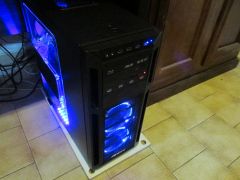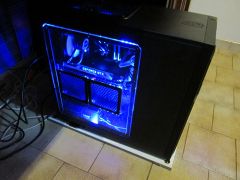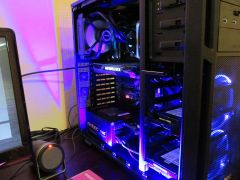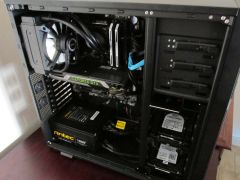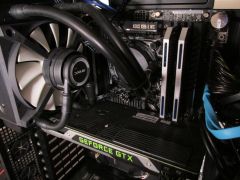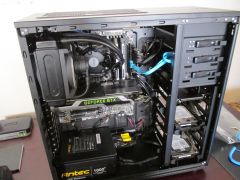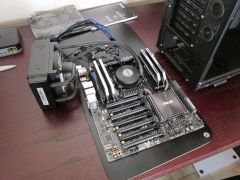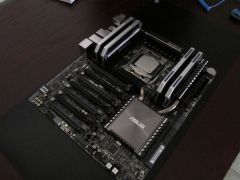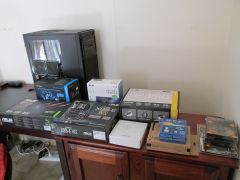-
Posts
13 -
Joined
-
Last visited
Awards
This user doesn't have any awards
Profile Information
-
Gender
Female
-
Location
Sydney, Australia
-
Interests
Cooking/Eating Pasta, PC Games, Swimming & Cats
-
Biography
I live in Sydney Australia and work at an accounting firm. I love to play PC games such as Tropico, Age of Empires, Halo, Elite and Flight Simulator. In summer, I do a lot of open ocean swim races (under 3km only). I have 2 cats - Milo & Gizmo.
-
Occupation
Admin Clerk
System
-
CPU
Intel Core i7-5820K
-
Motherboard
Asus X99 E-WS
-
RAM
Corsair Dominator Platinum DDR4 32Gb@2666 Mhz
-
GPU
Asus GeForce GTX 980 reference card
-
Case
Cooler Master MasterCase Pro 5
-
Storage
Samsung 850 Pro 1Tb / WD Black 3Tb / 500 Gb WD Velociraptor
-
PSU
Cooler Master V850 Modular
-
Display(s)
Asus PB278Q 27 inch 2560 x 1440
-
Cooling
Cooler Master Nepton 240M
-
Keyboard
Logitech G710+
-
Mouse
Logitech G602
-
Sound
Onboard/Logitech Speakers
-
Operating System
Windows 10 64-bit
KatetheSuperfish's Achievements
-
KatetheSuperfish changed their profile photo
-
LOL! Thank you... and for the Samsung link as well. Should I wipe clean the data on SSD's taken out of one PC before cloning/installing into the next PC?
- 2 replies
-
- ssd
- operating system
-
(and 1 more)
Tagged with:
-
Currently I have the following boot drives in my PCs: Desktop (Windows 10) - 1TB Samsung 850 Pro 2.5 inch SATA SSD Laptop #1 (Windows 10) - 500 GB Samsung 850 Evo 2.5 inch SATA SSD Laptop#2 (Windows 10) - 1 TB Mechanical HDD original hard drive when laptop was purchased I am planning to purchase a 500 GB M.2 SSD to replace the 2.5 inch SATA SSD currently in my desktop as the boot drive. The 1 TB 2.5 inch SSD will then go in to Laptop #1. And finally the 500 GB Evo SSD presently in Laptop #1 I intend to put into Laptop #2 as a replacement for the 1 TB mechanical HDD. I am a little unsure about how to proceed with this. I know that I will need to use Acronis True Image or some other similar cloning software and really would like to avoid having to do Windows 10 clean installs on any of my computers. Any advice on how to go about this project would be appreciated.
- 2 replies
-
- ssd
- operating system
-
(and 1 more)
Tagged with:
-

PC does not power on properly
KatetheSuperfish replied to KatetheSuperfish's topic in Troubleshooting
Well, I tried the PSU on loan from a friend. My PC powered on as it should each and every time I pressed the case's power switch. So, I guess its time to RMA my Cooler Master PSU. Thanks all for the assist. -

PC does not power on properly
KatetheSuperfish replied to KatetheSuperfish's topic in Troubleshooting
At first I tried waitng 10 - 15 mins before re-plugging the power cord and starting up the PC. When that didn't work I waited 2 hours, then overnight before it powered up. Yes, it will be interesting to see if a different PSU will change things. -

PC does not power on properly
KatetheSuperfish replied to KatetheSuperfish's topic in Troubleshooting
Once it boots it works great. Even under load it performs well, temps are normal and shows no signs of being faulty. And it passed both memtest and the Asus PC Diagnostics memory stress test. Yes, the PSU is under warranty. Just have to see what happens with the borrowed PSU. So, you said strange things will happen when PSU capacitors go bad. Will a PC sometimes work well and appear all ok even though the PSU is dying? *thanks for your help* -

PC does not power on properly
KatetheSuperfish replied to KatetheSuperfish's topic in Troubleshooting
Thanks for the assist. I just read somewhere that holding down the power button when PC is unplugged drains any residual charge from the motherboard capacitors. You both right though, the PC powered up skipping that step and just leaving it unplugged for some hours. On the flip side doing the power button hold down and attempting to start the PC straight away did not work. I will be borrowing a working PSU tomorrow and see if that works. Until then I will try memtest. -
I upgraded my PC just before Christmas 2015. The case, power supply and CPU cooler were changed. Specs are below. The PC was working great, but in the last few days my PC will not power on (cold boot) properly. When I press the power button absolutely nothing happens. No fans, lights, not even a flicker of any activity. However, the motherboard's LED lights are on. Through trial and error I have found that I am able to power it up by unplugging the PSU from the wall power socket, pressing and holding down the PC's power button for a minute and then leaving the PC off and unplugged for approx 7 - 8 hours. Once I have powered it up, it seems to be working just fine. Using this unorthodox power on method, it POSTs, boots into Windows and performs as normal. I put the PC under load by rendering a 1440p video, doing a multiple file transfer, playing an MP3 track and typing a document simultaneously. Then I ran a Prime95 blend test for an hour. Temps were good, fans working, LED lights on steady and bright. It also restarts without a problem. I have done the following troubleshooting steps: Checked power cable securely plugged into wall socket and PSU. Also checked the PSU and motherboard's 24 pin & 8 pin power connections. All ok. Checked all other connections between the PSU, motherboard, internal drives etc. All ok. Checked for any pinched cables, exposed wiring and signs of a short circuit inside case. Nothing found. Swapped power and reset switch front panel connectors on motherboard. Shorting the power pins on motherboard. Tested wall socket by plugging in 2 other appliances and confirmed wall socket was delivering power. Used 2 different PSU power cords. Moved the PC and plugged into 3 other wall sockets around the house and finally on 2 different sockets at my neighbor's house (steps 6 & 7 were done at each socket before PC plugged in). Same result with all of the above. PC will only power up by going through the procedure mentioned earlier. Any advice would be appreciated. Intel Core i7-5820K (overclocked to 4.0 GHz) Asus X99 E-WS motherboard Corsair Dominator Platinum 32 GB (4x8GB) at 2133 MHz (XMP disabled) Asus GTX 980 reference graphics card (overclocked to 1236 MHz boost clock, 7010 MHz memory clock & 110% power target) Cooler Master Nepton 240M AIO CPU cooler Samsung 1TB SSD (system), 500 GB WD Velociraptor (storage) and 3 TB WD Black (storage) Asus Blu-Ray optical drive Silverstone 5.25 inch front bay card reader 3 x 140mm case fans (2 with Blue LED) Bitfenix 300mm Blue LED light strip Cooler Master V850 Gold power supply Cooler Master MasterCase Pro 5 case Windows 10
-
Upgraded my PC just before Christmas last year. Changed case, PSU and CPU liquid cooler. Memory now 32 GB.
-
I have a GTX 980. Clock is at 1147 MHz, memory 7050 MHz and voltage at 1188 mv. I just enabled the gaming profile on GPU Tweak.
-

New PC January 2015
Images added to a gallery album owned by KatetheSuperfish in Members Albums Category
-
Temps are much better than before. One core (or thread?) got to 57°C in the Prime95 blend test and the reached a max of 54°C after running this stress test for two and a half hours. As I as I can see it also has not slowed itself below my overclocked 4.2 GHz since the fix. Thanks all for your help & input.
- 13 replies
-
- cpu
- intel core i7-5820k
-
(and 1 more)
Tagged with:
-
I took your advice, Techguru as well as Deagon's. Thanks so much. The cpu cooling block was unfastened, cleaned the the thermal paste off, reapplied thermal paste (a little less this time) and re-installed the cooling block making sure it was nice and tight against the cpu. I replaced one of the 120mm fans attached to the radiator, that was making a whirring noise and seemed to be spinning a little unevenly and slower than the fan next to it. Also moved the PC into another room on the "cooler" side of the house. Ok, on idle the temps are now 30° - 33°C. Then I rendered a 20 min HD video and the temps were 45° to 50°C. I'm doing a Prime95 blend test at the moment and temps are hovering around 53°C. The CPU has also maintained 4.2 GHz so far. Thanks to you both and all the others who have posted. I'll keep the stress test going for another hour or two and post the results in the morning.
- 13 replies
-
- cpu
- intel core i7-5820k
-
(and 1 more)
Tagged with:
-
So the cpu is powering itself down, because of the heat. I have had a couple of unexpected restarts since I OCed it. I just thought that the liquid cooler could handle it. And I also thought thst 4.2 GHz at 1.35 core voltage is a moderate and conservstive OC. I kinda remember that it was just reaching 70 deg C during my post-overclock stress tests. Should I bring the CPU down to maybe 4.0 GHz or 3.9 GHz and lower the core voltage as well? Would that bring down my temps so that the CPU doesn't throttle down anymore?
- 13 replies
-
- cpu
- intel core i7-5820k
-
(and 1 more)
Tagged with:
-
I am using an Antec 120mm liquid cooler (with push pull fans). Temps are averaging 45 - 50 deg Celsius when idle. It hovers around 68 - 72 deg Celsius under load. That's not too hot is it? Thanks Kate
- 13 replies
-
- cpu
- intel core i7-5820k
-
(and 1 more)
Tagged with:
-
Hi, I am new to this forum. I built my PC earlier this year. The specs are down below. I have done a moderate overclockon the CPU to 4.2 GHz. The GPU is also slightly overclocked & have enabled XMP. However occasionally I notice that my PC runs slower than usual & discovered that the CPU is running at around 800 MHz & it stays that way for some period of time. The next time I power up though it is running fine again at 4.2 GHz. Very frustrating. Has anyone else experienced this problem? Can someone please assist? Thanks very much. CPU: Intel Core i7-5820K MOBO: Asus X99 E-WS RAM: 16 Gb at 2400 MHz GPU: Asus GTX 980 (Reference card) Windows 10 Kate
- 13 replies
-
- cpu
- intel core i7-5820k
-
(and 1 more)
Tagged with:












